Syrian artist Khaled Takreti has spent the greater part of his twenty-year career exploring a personal history that stretches between Beirut, where he was born in 1964; Damascus, where he lived before moving to the United States in his early thirties; and Paris, where he has resided since 2004. The episodic nature of the painter’s oeuvre dates back to the 1990s, when he began to address self-reflexive themes through autobiographical composites. The culled figures of his canvases are based on his family and friends, and often include self-portraits; otherwise, fictionalized moments allude to exhumed apprehension or desire.
As protagonists and objects recur from one series to the next, Takreti seeks to unearth the psychological substrata that cement his connections to them, an approach that probes the fundamental constructs of social institutions by revealing the instability of the familiar. This conceptual strategy has constituted the basis of his art since 1995, when he overcame a period of debilitating grief through painting. The early works on paper created that year mark the start of a long cognitive passage, one that reached its creative terminus with the 2010 painting Generation. Through a series of portraits, the three-panel mural maps the familial links and inherited traits that molded his character from a young age. Although brought together, they are placed at different points of spatial depth within the composition, each indicating different temporalities.
Takreti renders his subject matter with the stillness of photographic imagery in artificial spaces where interplays between color, patterned ornamentation, and hard-edge lines stand in for absent narration. Such pictorial ambiguity displaces the veracity associated with realism, allowing the artist to mine the cavities of experience where memory takes over and visions of the everyday stand in for the subconscious. Objects enter his compositions as recovered forms, metaphysical access points. This perceptive intimacy is initially subjective, rooted in the flux of recollection and the structures of memoir, yet Takreti’s “Pop-stance” painting style, with which references to time are made visible, establishes his works as reflective of modern life.
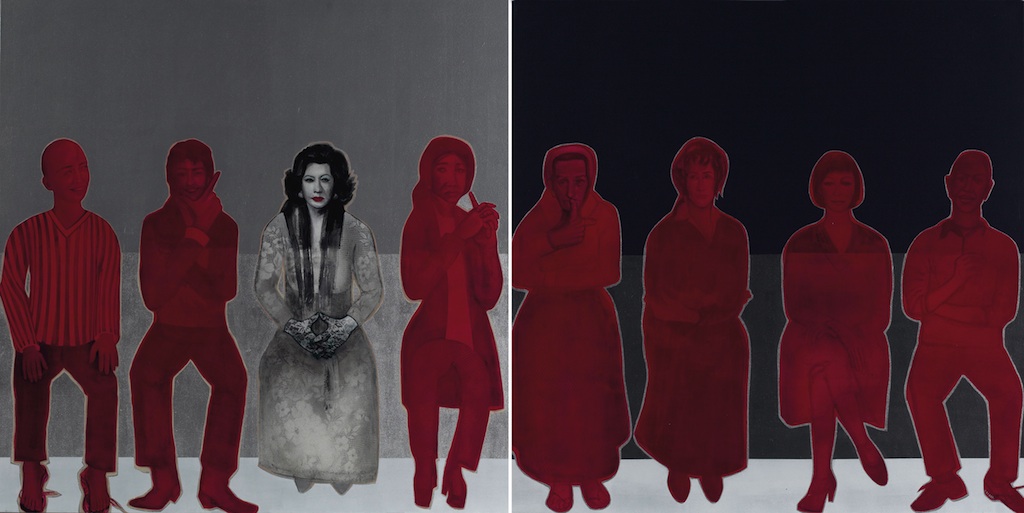 [The Second Marriage (2011). Image copyright the artist. Courtesy of Ayyam Gallery.]
[The Second Marriage (2011). Image copyright the artist. Courtesy of Ayyam Gallery.]
A Cognitive Passage
Although he expressed a love of painting and drawing throughout his childhood and adolescence, Takreti trained as an architect at the University of Damascus. This educational path served to appease his parents, and after graduating in 1992 he accepted a position in the architectural division of Syria’s Directorate General of Museums and Antiquity. Three years into his post, he grew restless; deciding a change of scenery would cure his boredom, he traveled to New York.
While living in the United States, he received news of his maternal grandmother’s passing—an event that left him devastated. Unable to quell a persistent melancholy, he returned to Syria the following year and unconsciously proceeded on a path of mourning through art. As the artist was a few months into this course, a friend encouraged him to exhibit his work. Feverishly, he finalized Fantasia, a collection of intricate works on paper with compositions that extend to the surface of their frames: scenes of flora and fauna submerged in water drifting from one dimension to another. Such imagery was unusual for a Syrian painter at the time, when besieged expressionist subject matter reflected a dominant current of local art. Nevertheless, he secured a solo show with Ishtar Gallery, a leading art space in Damascus. Expositions (1997) featured fifty paintings, forty-nine of which were sold on opening day.
Inspired by the overwhelming response to his first exhibition, Takreti continued painting, sifting through the creative and curative possibilities of working intuitively. In the early hours of one particular morning, he suddenly woke with a compulsive urge to paint. Impelled through the late evening, he produced seventy individual works, all containing a mysterious female face that morphs in sequence.
The series, titled Expressions (1997), was shown at Atassi Gallery, a venue whose influence as a hub for Syrian art outweighed that of local institutions. The featured works included watercolors executed in brown, black, and red hues. In each, a single front-facing figure is fixed with minimally defined formal reference to space, creating a startling impression of proximity. Burnt red washes or areas of fading black seem to dissolve the features of the unidentified heroine as she is shown in various stages, floating before the viewer. In a black and white portion of the series, her face becomes misshapen, and appears to gradually recede.
Despite the great contrasts in painting style and mood that distinguish Expressions from Fantasia, the exhibition at Atassi Gallery was well received. Dance (1997), Takreti’s subsequent body of work, was shown at the Goethe Institut in Damascus and summoned the movement of his first series while utilizing the pared down palette of the second in ink. Its thewy protagonist bows, extends, leaps, and falls across picture planes, her agility delineated with thin, dark lines where veins or muscles travel through the length of her body. The robust build of the performer is his most considered investigation of the human form to date.
The artist’s early works, although seemingly removed from his more recent portraits and scenes, laid the groundwork for his approach to figuration as exercises in structuring compositions exclusively around the physicality of his subjects. These initial paintings and drawings also required a particular skill set, as the surface of paper is fragile and limited in its absorption of medium, and successful execution involves measured application. In the Dance series Takreti concentrates on the figure with calligraphic detail, leaving the remaining surface of each piece exposed as a white void. Compelling the viewer to follow the contours of her frame as she glides and bends, the pictorial isolation of his muse implies a prolonged state of withdrawal as she is depicted in various poses. Such formal treatments prefigure his later acrylic on canvas paintings, primarily the use of non-tactile color planes or patterns as backgrounds that amplify the dimensional qualities of his figures with a sort of graphic breakdown of portraiture.
The elusiveness of his female protagonist remained intact for several years as Takreti struggled to understand her haunting presence. With distance and retrospection, however, clues to her identity became clear. As common threads appeared across series, his female lead seemed to demand that her persona be wholly realized. The gaunt face that emerges in Expressions, for example, resurfaces in the full-length renderings of Dance.
Takreti arrived closer to uncovering the unnamed figure’s image with the half-length portraits comprising Woman I (1998). Through different portrayals of his primary subject, her statuesque form comes into view. No longer existing as an apparition, the woman’s features are defined for the first time. An untitled painting in profile emphasizes her elongated neck. In others, her strong, sloping shoulders lean to one side as a cascade of hair frames her face. Executed in scorched shades of red and subdued variations of black, color alludes to an enduring ephemeral space as she pensively looks away. A crimson vapour lights up the background of one portrait; in another, a rust-colored torrent washes over her as she is depicted as a bride. Woman I also reflects the artist’s nominal engagement with expressionist techniques while working in Syria. Such stylization, however, proved to be more experimental than decisive. In the years prior to his move to Paris, he developed a method of figurative painting that set him apart from his colleagues.
Takreti’s prolific early period culminated with a solo exhibition at the eponymous Damascus art space of the late Syrian modernist Fateh Moudarres. Silence (2004) featured works that introduced a new aesthetic direction. The series evolved from Homage to Maghout (2002), a transitional piece dedicated to influential Syrian poet and playwright Muhammad al-Maghout. The singular work depicts a new bride surrounded by her extended family, a group portrait that is distinguished by its compact composition and angular forms. The painting’s figures are distributed between two horizontal rows that make up its foreground and middle ground. Representing several generations, the men and women seem to sway in unison as they lean in and their shoulders overlap. Thinly painted geometric shapes over certain areas of the composition add to this illusion of movement. At the midpoint of the foreground is a woman whose face is partially hidden by the long veil that falls from the crown of the bride. Dressed in black and resembling the protagonist of the artist’s Femme I series, she balances the painting as a central axis and is positioned as though the remaining characters stand behind her. Painted with clarifying detail and within the context of her life, the artist finally identifies his muse: the matriarch is his maternal grandmother, Leila. In the lower right-hand corner of the work, a young man is set apart in a transparent upright rectangle as he looks out towards the scene. From a distance in space and time, the adolescent Takreti stands in search of his own biography guided by the stabilizing force of his grandmother.
In the acrylic on canvas paintings shown in Silence, Takreti extends this vantage point through pictorial devices that describe portraiture as the retrieval of memory. The artist’s subjects appear flattened with controlled depth in a manner reminiscent of Assyrian reliefs; a restrained use of spatial depth and volume that is also found in early modernist painting. In ancient art, this technique was utilized in friezes and wall paintings in the creation of narrative sequences through which multiple moments in time are communicated. With the development of modernist painting, such stylization served as a self-referential facet, reminding the viewer of the artifice of figuration alongside its engagement with reality. The limited dimensionality of Takreti’s protagonists serve both narrative and formal functions, undermining the traditional role of portraiture as representative of a subject in a given time and space. Instead, an emphasis is placed on subjective experience, specifically the emotive associations that arise as he relies on memory to reconstruct their images.
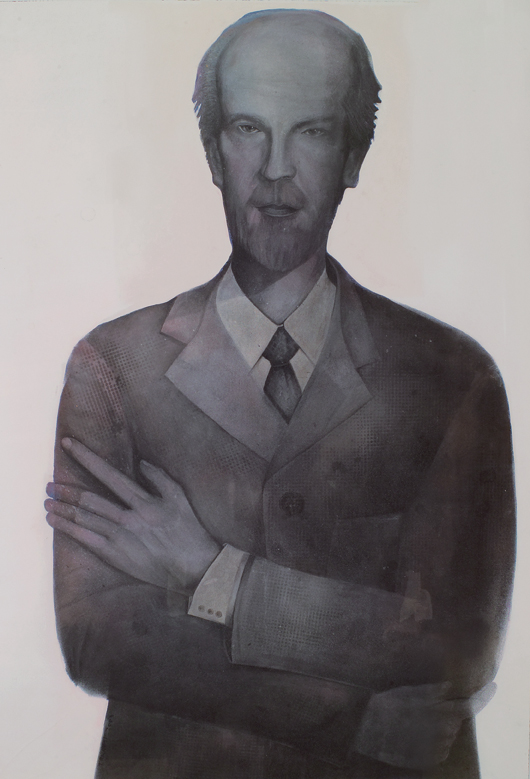 [Untitled (2003). Image copyright the artist. Courtesy of Ayyam Gallery.]
[Untitled (2003). Image copyright the artist. Courtesy of Ayyam Gallery.]
In a 2003 untitled group portrait, for example, the artist arranges four figures in tiers as they face different directions; their soft-edge bodies resembling cutouts. Although clustered, they appear to belong to different scenes—joined within the composition as excerpts from specific moments. In the lower right-hand corner is a portrait of the artist as a boy. The young Takreti stands with his back to his maternal grandparents and mother, who tower over him; his eyes are closed as he retreats into the whisper of a conch. The end of his mother’s long mantilla sweeps over his face as she passes, signaling a second sensory experience. The painting’s muted palette is characteristic of the series, and heightens the signified remoteness of its spatial organisation. A gradation of faint hues accumulates as a white haze in the background, and descends onto the upper bodies of the adult figures, suggesting a separate dream state. Soft orange shadows are cast along the outer ridges of their faces, matching that of the boy, whose body glows. These select areas of color register what Julia Kristeva describes as “an index of value” and “an instinctual pressure.” For Kristeva, color in painting is “pulled from the unconscious into a symbolic order,” and functions as “the dialectical space of a psycho-graphic equilibrium.”[1]
 [Untitled (2003). Image copyright the artist. Courtesy of Ayyam Gallery.]
[Untitled (2003). Image copyright the artist. Courtesy of Ayyam Gallery.]
Color, although instinctual throughout Takreti’s initial development as an artist, became increasingly important as a formal index of value when he moved to France. As Silence was his final exhibition in Syria before he left for Paris, the sombre palette of its included works is presumably symbolic.
Metaphysical Pop
The shift occurred quickly, and was made evident in the form of a whimsical collage. I Seek Freedom (2005)—the first work the painter created in France—playfully declares the driving force behind the second major change in his aesthetic. The experimental piece plots this new phase with metaphoric vignettes that are placed side by side as a surrealist street scene.
The narrative begins in the upper portion of the composition, where a moped-riding couple faces the viewer. Above the male driver are speech bubbles that read “Je cherche la liberté,” the painting’s title in French. His female companion wears dark sunglasses made from a magazine cutting. While the starting point of their journey is unknown, as an abstracted space behind them provides no further clues, a congested city is shown at sunset to the right of the pair, its evening sky radiating in a bright orange light. A broad, pink middle ground transitions into a third scene where the same duo passes over a cobblestone road as they continue to their destination. In the foreground of the composition, a gangly plant stretches beyond the physical edge of the painting. The inclusion of this floral object is revealing, as it appears in earlier examples of the artist’s work, particularly in paintings that were executed during acute moments of sorrow. Attached to one of its branches is a small birdcage from which a miniature boy looks out; a few branches above is a cutout eye that stands in for a leaf, yet the couple rides on without taking notice.
The mixed media work was followed by a series of paintings that extends this conceptual thread with a similar use of symbolism and metaphor. In Les Grand Enfants (2006-2007), Takreti alternates between loosely painted bodies and meticulously realized figures, and employs a cool palette in order to stress the meditative, and sometimes downcast, mood of his protagonists. Initially inspired by the artist’s friend Alexis, the series also includes self-portraits. In a number of works, toys or childhood fixtures such as a carousel or playground transform the empty or sparse environments of the men. Building on the symbolist conventions of I Seek Freedom, the artist strips his inanimate motifs of their materiality by placing them within the composition counter to the “logic” of their ordinary uses. Fictitious or ambiguous spaces created with expansive areas of color accentuate the incoherency of these objects and allude to a domain beyond their surfaces, breaking the “chain of memories” as Metaphysical painter Giorgio De Chirico argued.[2] In a self-portrait, Takreti reaches for a toy car that levitates above him while another floats by in an adjacent area of the painting. The artist stands against a blue atmospheric background that appears as infinite space.
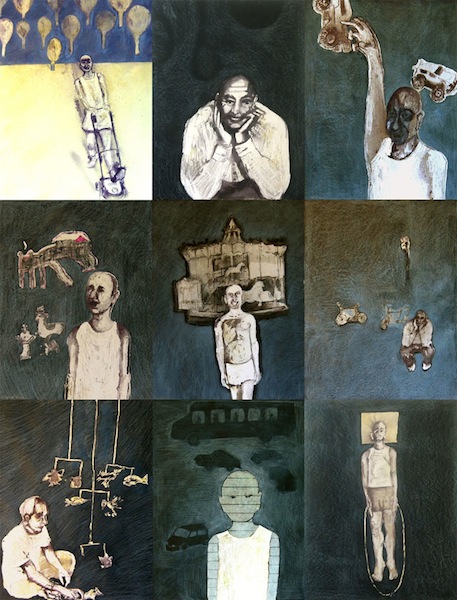 [Untitled. Image copyright the artist. Courtesy of Ayyam Gallery.]
[Untitled. Image copyright the artist. Courtesy of Ayyam Gallery.]
These objects grew in size in subsequent paintings as Takreti revisited specific periods of his life with renewed formalism. The artist’s return to previously explored topics with a refreshed perspective brings to mind Surrealist poet and art critic Nicholas Calas’ observation that: “Addiction to images is a dream derivative.”[3] In the large-scale series My Grandmother and I (2007-2008) and I am a Teenager Again (2009-2010), Takreti introduces the vernacular of popular imagery with high concentrations of color and clear-cut compositional designs. This places the focus of each work on the body language of his subject(s). An emphasis on mid century fashion and domestic things work in concert with such technical configurations, allowing the artist to situate his characters in time without the need for additional narratives devices.
In Blue (2008), the placement of two figures on separate panels of the painting suggests a delicate tension. The diptych shows the artist and his mother when he was approximately ten years old. Standing on a child’s metal scooter while wearing a bright purple bow tie and white clothing, he appears ready to ride away. The elegance of his suit matches that of his mother who wears a flowing gown, thus confirming the presence of the scooter as metaphoric rather than functional. Modest means of transportation reappear in several works created by Takreti in France, and often signal a formative journey that is either underway or approaching. A second bow on his mother’s handbag links the two figures while an evenly distributed pink and blue background extends to the foreground, counterbalancing the gap between them.
.jpg) [Blue (2008). Image copyright the artist. Courtesy of Ayyam Gallery.]
[Blue (2008). Image copyright the artist. Courtesy of Ayyam Gallery.]
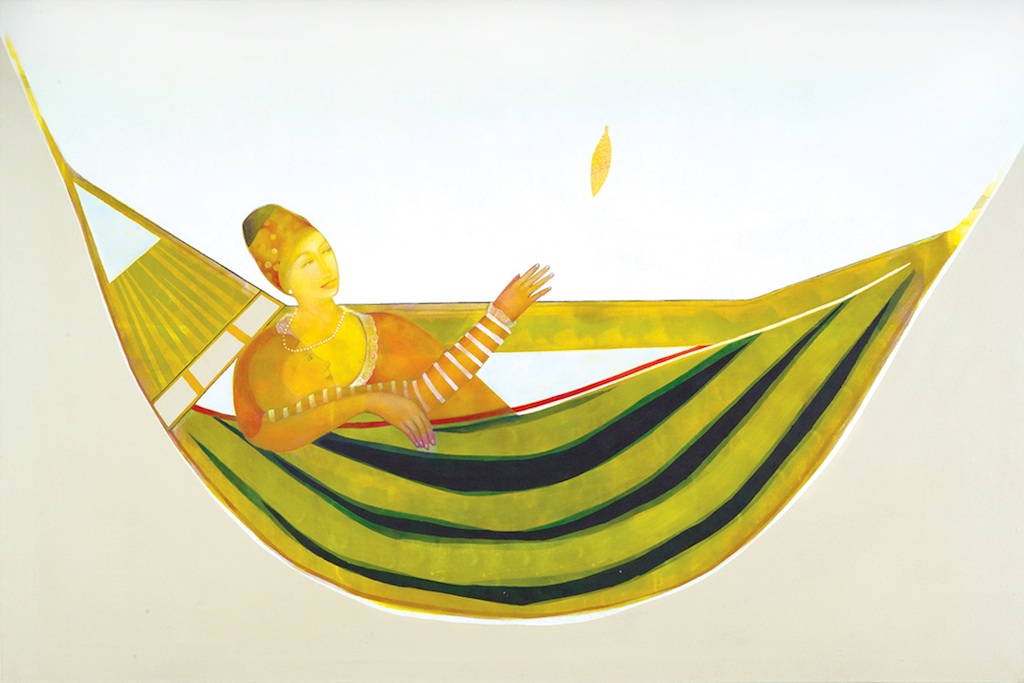 [Souvenir d`Enfance (2008). Image copyright the artist. Courtesy of Ayyam Gallery.]
[Souvenir d`Enfance (2008). Image copyright the artist. Courtesy of Ayyam Gallery.]
In other paintings of the two series, the inclusion of furniture sometimes hints at the context of the depicted scene or event while items such as a letter appear as poetic details alluding to affecting exchanges between protagonists. The respective palettes of the two series are telling of Takreti’s comprehension of his past: white backgrounds punctuated by pastels represent the quiet of his childhood as he is sheltered by his grandmother and mother; brilliant swathes of color ignite the bursting energy of amorous teenage adventures.
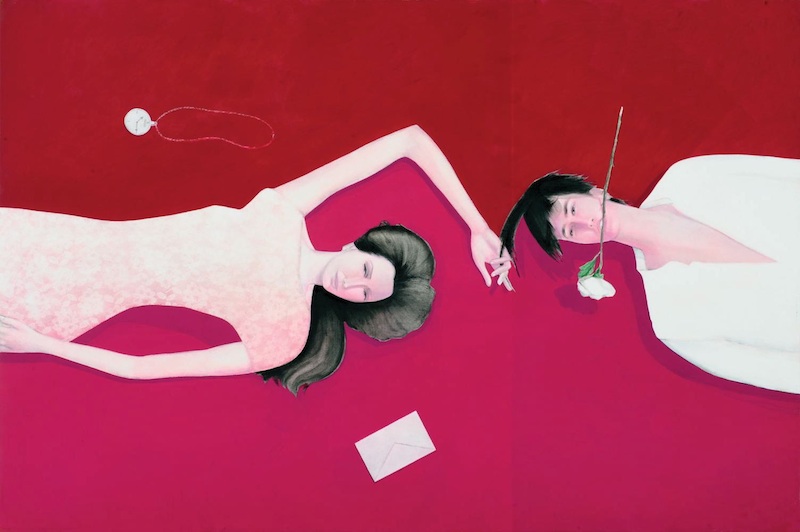 [Nous Deux (2010). Image copyright the artist. Courtesy of Ayyam Gallery.]
[Nous Deux (2010). Image copyright the artist. Courtesy of Ayyam Gallery.]
Homage to Al Beik (2009), a standout work of the latter series, demonstrates the transfer of Takreti’s autobiographical gaze from an internal investigation of memory to the external realm of the present. The painting is titled after Syrian photographer and filmmaker Ammar Al Beik, who is shown leaning over a bulky camera in the lower left-hand corner of the composition. His curved form is painted in partial shadow, an effect that is reminiscent of Takreti’s own image as a boy in the familial portraits that depict him as an outside raconteur. The artistic similarities between Takreti and Al Beik are manifest, both are known for offering rare, intimate views of Syrian society. Red beams of light shoot out from Al Beik’s lens, spotlighting a rose-colored muse. The director wears a thawb, a long traditional tunic that is typically worn by an older generation of men in the Levant. In the painting, the voluminous contour of the robe stabilizes the composition; a theatrical nod to a bygone era, the costume presents Al Beik as a guardian of his craft. The filmmaker’s subject is a young woman who stretches to provide a perfect pose. Cosmetics are flung in the air as she arches her body, and the rays of his camera make it shimmer with color.
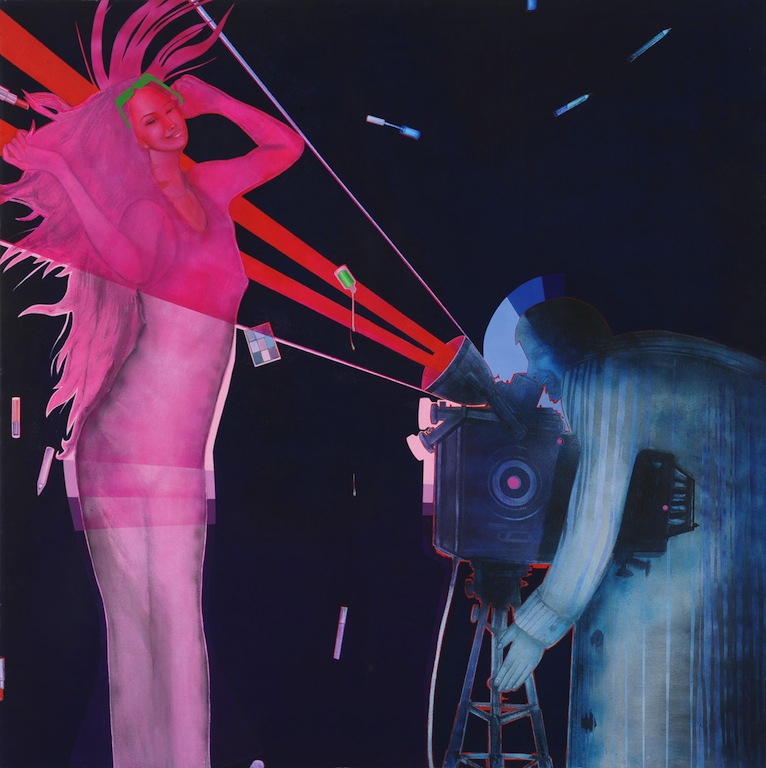 [Homage to Al Beik (2009). Image copyright the artist. Courtesy of Ayyam Gallery.]
[Homage to Al Beik (2009). Image copyright the artist. Courtesy of Ayyam Gallery.]
Homage to Al Beik resembles a filmed scene paused in a moment of action. While Takreti integrates the element of time and movement, the distinguishing facets of cinema, he returns to the field of painting with the exaggerated hues of his palette and the stylization of his figures. In this regard, the artist has “personalized” cinematic forms while leaving traces of the devices that conventionally underline a film’s content. Looking beyond the formal boundaries of his medium, he emphasizes the psychological undertones of his subjects in ways that speak to the media-saturated sensibilities of today without abandoning the contemplative focus on the figure that constitutes portraiture.
Postmodern Pop
In My Grandmother and I (2007-2008) and I am a Teenager Again, Takreti’s recurring characters began to embody what Brendan Prendeville identifies as the “cool modern urban persona,” a type of representation employed by figurative painters who recognize “the cultural transformation brought about by the accelerated growth in communications media and associated technologies.”[4] Commenting on the state of realism in the late twentieth century, Prendeville observes that an abundance of mass media imagery has made modern life “wholly virtual,” prompting artists to “present reality indirectly or as if through a screen” as they question the “truths” of “tradition and representation by way of contemporary visual culture.” In the two series, Takreti’s figures are silhouetted with a fine line (usually in white) that distinguishes them from their backgrounds, an illusion that suggests their images have been extracted from a secondary source. With this added component, he seems to imply that today’s omnipresent media inform even the subjective ambits of memory and perception. Interestingly, in an exhaustive study Bradford R. Collins argues that Pop art appeared in Western Europe and the United States in the mid twentieth century as a “mode” with which artists addressed the changing face of modernity. According to Collins, Pop art emerged as a “watershed development in modern art” when artists began to accept that “the media imagery of mainstream capitalist culture, from advertising to comics to movies, had become, whether they liked it or not, the stuff of their consciousness.”[5]
As Takreti embraced the formalism of Pop art in his portraits, particularly with reference to mechanized imagery, he adopted a postmodern line of inquiry. Although his interest in the process of recognition and the (in)stability of the familiar continued to guide his approach to portraiture, he progressively blurred the lines between painting, photography, and popular images in order to reveal the remoteness of the present. Beginning with Generation, his recent paintings reflect reality as it is determined by a steady flow of signs.
In Generation, five distinct portraits resemble cutouts of hand-painted studio photographs, as each figure is represented in black and white with select areas of color. Distributed over three large panels, the painting features the artist as a young child at its center. Takreti’s boyhood image is divided in two with a black line that extends from the top of the canvas to its bottom edge. To his left and right are his parents, whose shoulders overlap to provide a protective barrier. To the left of his father is his paternal grandmother, matronly and stoic, and adjacent to his mother is his maternal grandmother—the serene vision that has often graced his canvases. Placed at a noticeable distance from the others, Leila’s position within the structure of the artist’s ongoing memoir has changed as he finally acknowledges her absence. Takreti wears a metal skullcap, a childhood crown of invention that connects him to the additional figures with corresponding wires and candy-colored electrodes. Fragile surges of energy run between the physique of his paternal grandmother, the mind of his father, the pulse of his mother, and the heart of his maternal grandmother. By outlining these familial links, he creates a self-portrait that is pieced together with retrieved relics from the past.
In 2012, Takreti returned to the earlier theme of melancholy in Silence and created a second series of portraits with the same title—this time in response to the outbreak of conflict in Syria. Replicating the appearance of mechanized images while eliminating the index of values that situate his earlier works, he created an aesthetic of mourning. Color “escaped” his palette; and in several paintings, the raw surface of the canvas remains exposed. In the absence of vibrant, instinctual hues, the faces of his figures are obscured by shadows. Many of his solitary protagonists, including Leila, seem to float within their respective compositions, depicted in limbo, as the spaces around them are undefined. When describing the minimized forms of the series, Takreti asserts that such subject matter requires a “direct” approach, calling to mind Aaron Kerner’s argument that “form above content” is integral to depicting the catastrophic. For Kerner: “When representing the abject [the sociological site of corruption that fuels catastrophe], it manifests not in a narrative per se, but as a vision, an impression, a poetic release of drive energy.”[6]
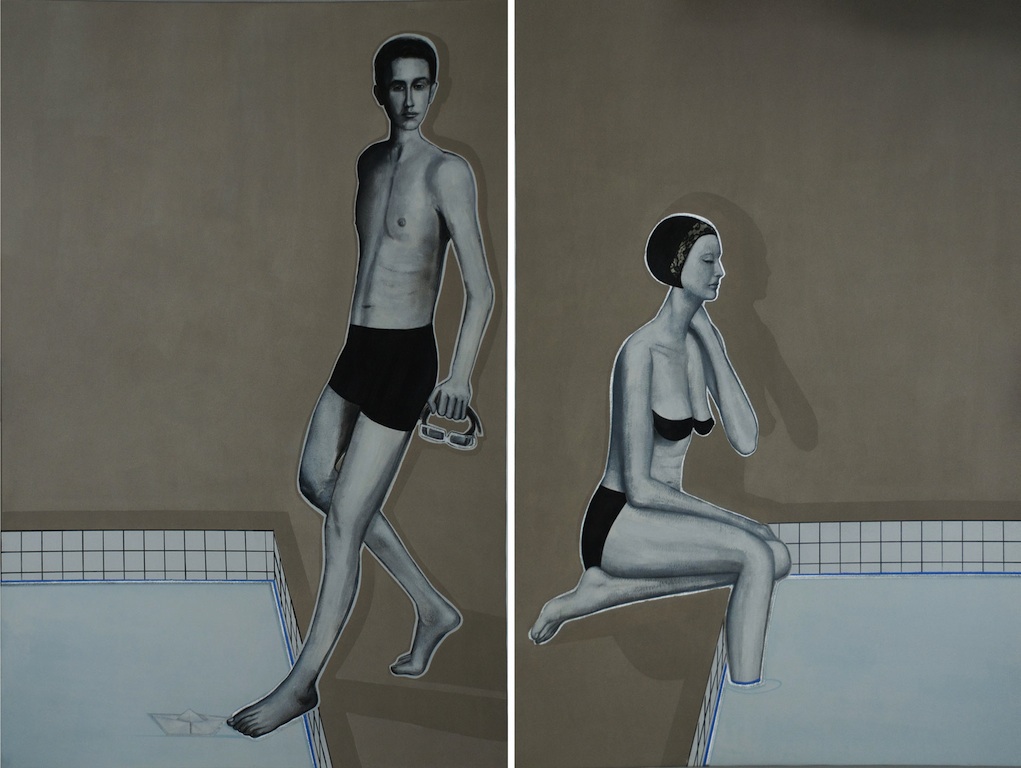 [Loveboat (2011). Image copyright the artist. Courtesy of Ayyam Gallery.]
[Loveboat (2011). Image copyright the artist. Courtesy of Ayyam Gallery.]
In Complete Freedom (2013), Takreti expanded this theme while further altering his painting style. Combining found images and photographic studies, his figures and objects are collaged then manipulated and reprinted before they are applied to bare canvases where they are reworked as “etchings.” The photographic precision that results from this process alludes to the artifice of advertising, social media, and other normalizing imagery. Rendering modern life as a tableau of the absurd driven by anxiety, chaos, and apocalyptic violence, he comments on the intrinsic corruption of the various types of “freedom” that are advocated through mass culture. Despite the overt skepticism of Complete Freedom, its centerpiece, Ca Roule (2013), confirms its place within the broader visual record that has stretched through his many years of painting. A self-portrait of the artist balanced between the wheels of a bicycle, the painting recalls earlier works in which Takreti is shown in mid journey at different points in his memoir.
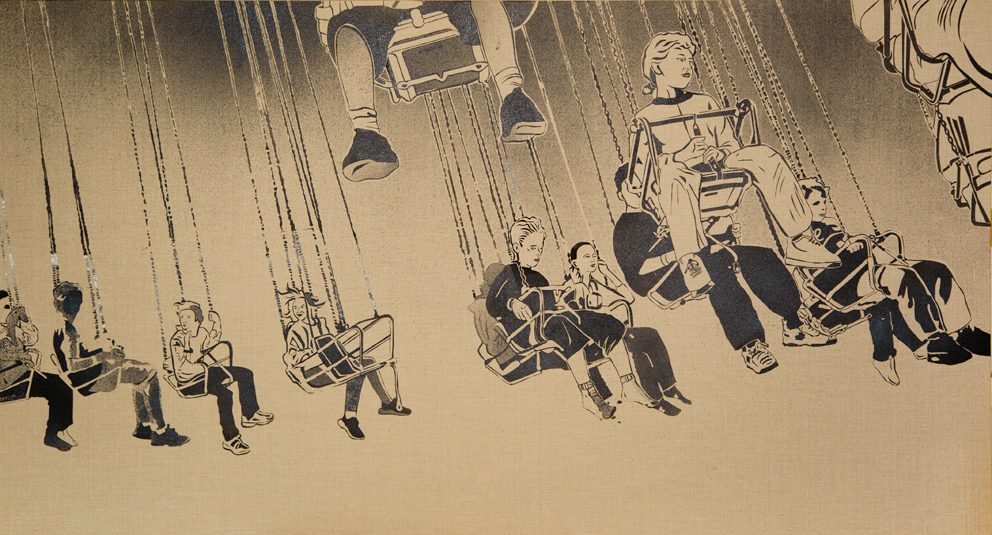 [The Children of Syria (2013). Image copyright the artist. Courtesy of Ayyam Gallery.]
[The Children of Syria (2013). Image copyright the artist. Courtesy of Ayyam Gallery.]
 [Ca Roule (2013). Image copyright the artist. Courtesy of Ayyam Gallery.]
[Ca Roule (2013). Image copyright the artist. Courtesy of Ayyam Gallery.]
The artist’s latest series LOL resumes this sociocultural thread while demonstrating his ongoing interest in the buried psychology of the everyday. Takreti’s unparalleled Pop art aesthetic has established him as one of the most significant Arab artists of his generation, and a foremost innovator of contemporary Syrian art. In Syria, a country whose visual culture has reflected its social development alongside its political ebb and flow, Takreti has provided fellow artists with the aesthetic tools to forge ahead, particularly at a time when cultural practitioners are forced to navigate the conflict and its many realities in order to proceed. The importance of artists like Takreti who serve as subjective “truth” tellers also has implications in the very make up of history, which, as Aaron Kerner reminds us: “is always a series of fragments—of trace memories.”[7]
The above essay is excerpted from the recent monograph Takreti (Dubai: Ayyam Gallery, 2014), which can be accessed online here.
Footnotes